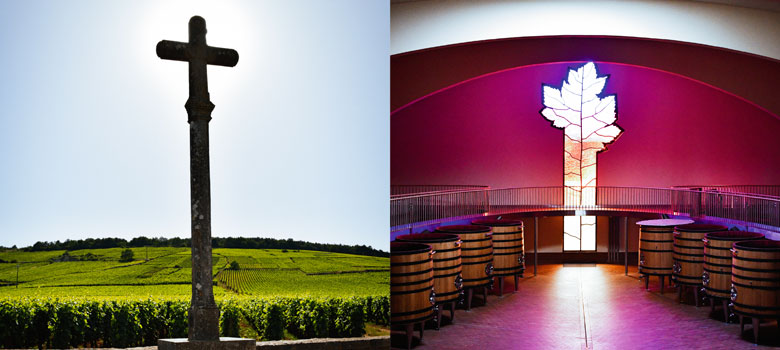
Wine
Burgundy: The Holy Grail
If wine regions were rings, the slopes of Burgundy would be the one to rule them all. The 124 kilometre strip of soil that runs diagonally north from Dijon through Beaune, Chalon-sur-Saône to Mâcon in the south is literally the most valuable dirt in the world.
A hectare of Burgundian Grand Cru soil would cost you around 16 million Euros and if you were to do the maths on your purchase, the reality of making wine in the region would sink in. Generally, there are 10,000 vines per hectare and in a good year, each yields 500ml of juice, equating to 350ml of finished wine. This translates to roughly 388 dozen.
If you decided on a 10-year time frame to make your investment back, notwithstanding vineyard and production costs, you would have to charge about €4,125 per case!
A Magical Mystique
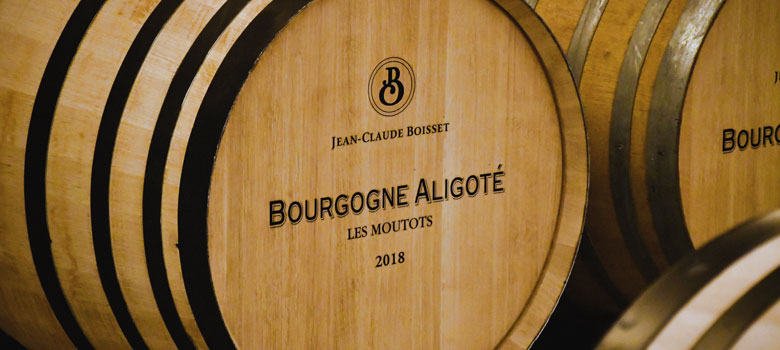
Pictured above: Aligoté barrel at Jean-Claude Boisset.
Burgundy, or Côte d’Or, produces some of the most revered wine in the world and has a mystique all of its own. Part of this stems from the fact that it has enormous influence on the world of wine, but in comparison, its output is tiny. Burgundy produces three per cent of all wine made in France and 0.4 per cent in the world. Yet its wines are flavour and stylistic beacons against which all decent Pinot Noir and Chardonnay, regardless of where they are grown and made, are ultimately compared.
Another contribution to this fascination is the mind-bending structural complexity of the region. Burgundy is a jigsaw puzzle made of 1,247 vine plots or Climats that are classified by a system of quality originally designed by monks in the seventh century.
Starting at the top with ‘Grand Gru’, followed by ‘Premier Cru’ (1er Cru), then ‘Village’ and ‘Regional’ (mostly labelled as ‘Bourgone’), these ‘appellations’ (numbering over 100) are then defined by the area or village (there are 42), with some having a separate Clos, or walled sections within the Climat.
Each of these Climats is unique, and when you then add the influential hand of the winemaker (there are over 3000 producers in Burgundy), you end up with a crazily complex wine-scape that takes years and years of attention to understand and appreciate. World-famous British Master of Wine Jancis Robinson provides a ‘nutshell’ description of Burgundy: “(A) small, expensive, infuriating, complicated region that delivers paradise in a bottle with increasing frequency.” A statement that is as accurate as it is brief.
For those in the wine industry, Burgundy is considered an essential pilgrimage. Iain Riggs AM, managing director of Brokenwood and overall wine oracle, holds a reverent respect for the region. “Truly great wine is all about great site,” he says, “and Burgundy has had centuries of evolution, experimentation and refinement. I think people still have trouble understanding it. Burgundy represents the Holy Grail of growing and
making wines.”
Thankfully, appreciating the vast delights produced along the Côte d’Or is easy and visitors are attracted to the approachable, almost rustic charm of the region.
Unlike the obvious opulence of regions like Bordeaux and Champagne, Burgundy and its people are warm and laid back. Exploring this region really is a joy as Burgundians see themselves as farmers and most producers operate as small family businesses, passing their property down through the generations.
The Holy Grail: Le Vin De Borgogne
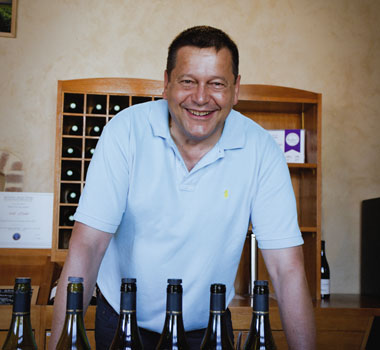
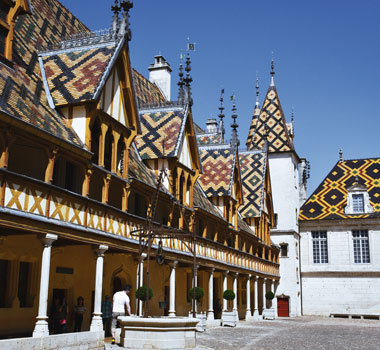
Pictured above (from left to right): Pierre Jhean, Director of Winemaking at Henri de Villamont in Savigny Les Beaune; The courtyard at L’Hôtel-Dieu.
Burgundy is grouped into five regions: Chablis, Côte de Nuits, Côte de Beaune, Côte Chalonnaise and Mâconnaise, with regionales making up their surrounding areas.
Pinot Noir and Chardonnay deliver 40 per cent and 51 per cent respectively to the Burgundy pie, along with Gamay, a light Pinot-like variety, and Aligoté, a white variety that’s sometimes blended with Chardonnay to make sparkling Crémant de Bourgogne, or as a single variety, with cassis liquor sometimes added to make a Kir.
The history and fortunes of Burgundy, however, are centred on Pinot Noir and Chardonnay and everywhere you go there are delicious multitudes to try, from the eye-wateringly expensive Grand Cru, to the approachable Village and Regional versions.
Dijon/Côte de Nuits
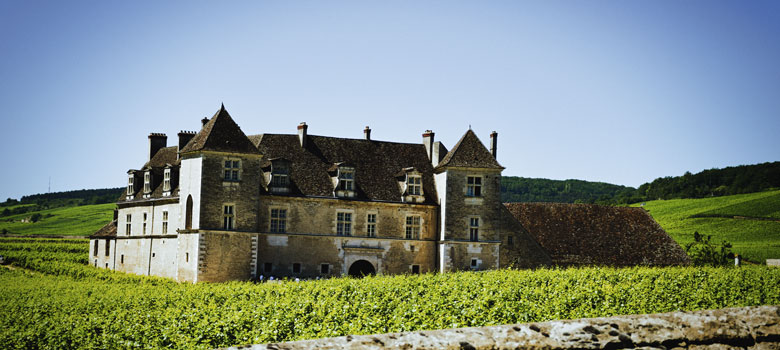
Pictured above: The historic Château Du Clos Du Vougeot.
In Roman times, Dijon was the crossover point between the Mediterranean and Northern Europe and became a city with great wealth and power. It became the home of the Dukes of Burgundy and as such had rich cultural heritage highlighted by art, food and wine.
Dijon is a great city to explore with loads of museums and sights all within walking distance. Highlights are the Place de la Libération, Palace of the Dukes of Burgundy, Cathédrale Saint-Bénigne de Dijon, Church of Notre-Dame of Dijon and Musée des Beaux-Arts de Dijon. One of the many culinary highlights of the city is Loiseau des Ducs, a one-starred Michelin restaurant by French powerhouse Chef Bernard Loiseau.
Dijon also has many wine bars serving every possible iteration of the region’s finest. Outside the city you will find yourself surrounded by Pinot Noir, with the villages of Marsannay, Gevrey-Chambertin, Chambolle Musigny, Vougeot and Flagey-Echézeaux all worthy of your palate and attention.
Before heading into Beaune, make sure to spend a night in the charming village of Nuits-St-Georges. Stay at Douce Nuits, a stylishly renovated apartment-style hotel within walking distance from the town square and the fabulous La Cabotte where you can sip 1er Cru Chardonnay as you watch the village go about its business.
For tastings, make appointments for Château du Clos de Vougeot, Domaine Drouhin-Laroze, Jean-Claude Boisett’s Cuverie des Ursulines, Domaine Rion and the incredible Vosne Tasting Club. If you are hungry, make sure you visit Château de Gilly-lès-Cîteaux, a glorious 14th century castle that is now a hotel, and have lunch at Clos Prieur.
Beaune-Côte De Beaune
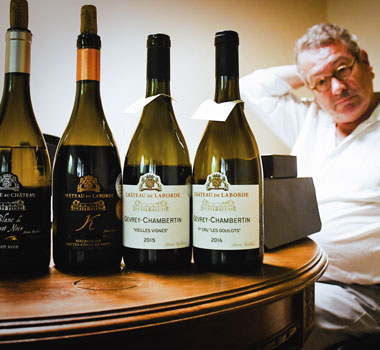

Pictured above (from left to right): The wines of Domain Hervé Kerlann; Hospices de Beaune.
Moving south from Nuits-St-Georges, you start to leave the muscular, Pinot-dominated Côte de Nuits and enter the Côte de Beaune where the Pinot becomes lighter, more perfumed. You also start to move into Grand Cru Chardonnay territory.
Beaune is a classic, walled town that is considered the wine centre of Burgundy. This beautiful medieval town has a population of less than 20,000 people and is one of those places where you find yourself saying, “I could live here.”
Just outside the village centre is the Hostellerie Le Cèdre, an elegantly French hotel with a beautiful courtyard garden attached to its restaurant Clos du Cèdre. Hostellerie Le Cèdre is perfectly positioned to explore Beaune on foot for a few days.
Must-sees in Beaune include the Hospices de Beaune or Hôtel-Dieu de Beaune, a 14th century hospice that eventually became funded by donations of wine auctioned every year. Then there’s the Fallot Mustard Factory where you get to experience the production of one of Burgundy’s most famous condiments and the incredible Maison des Climats, a scaled reproduction of the vineyards of Burgundy that must be seen to be believed.
For food experiences, spoil yourself at the Michelin-starred Loiseau des Vignes or even try a cooking class with Adeline at ‘Terroirs by Adeline’, a home-based cooking school and gastronomy centre.
As for Beaune’s most famous product, try for an appointment and tastings with Domaine Louis Jadot, Domaine Henri de Villamont and Maison Hervé Kerlann.
While there are plenty of ways to explore the wines of this region, these three producers make wine from all over Burgundy and will share three very different approaches and a unique perspective on the greatest Pinots and Chardonnays in the world.